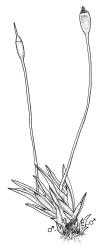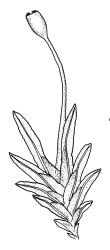Plants minute, 1–3 mm, yellow-green to dark green, loosely or densely gregarious. Stems simple or branched, with rhizoids at base of main stems and branches. Leaves in 3–6(–14) pairs, overlapping at mid stem, patent, decurved when moist, little altered when dry, lanceolate to linear-lanceolate, 0.7–1.3 × 0.13–0.20 mm; laminae unistratose; margins denticulate throughout, or only on dorsal and apical laminae; vaginant laminae c. ½ leaf length, open to partially closed; dorsal lamina failing above, or reaching the leaf insertion, tapered to its base; cells of apical and dorsal laminae irregularly quadrate to hexagonal, bulging, weakly to strongly unipapillose, with moderately thick walls, (6–)7–10(–12) × (6–)7.0–9.0(–10.5) µm. Costa failing 2–3 cells below the leaf apex to excurrent, bryoides-type in cross-section.
Autoicous or dioicous? Perichaetia terminal; perichaetial leaves longer than vegetative. Perigonia terminal on bulbiform or short shoots at base of female shoots, or on apparently separate bulbiform or tall plants. Setae light brown, 1.8–10 mm; capsules erect, symmetric, 0.4–0.7 mm; exothecial cells in 32–40 columns; operculum erect-rostrate from a conic base, ⅔ to equal the length of theca. Peristome bryoides-type; teeth with adaxial trabeculae fimbriate below the bifurcation. Calyptra smooth to scabrous, cucullate. Spores 7–14 µm.
An account of F. tenellus in N.Z. was given by Beever & Stone (1999) who summarised, from an Australasian perspective, the various taxonomic interpretations given to this species and its allies, namely F. australiensis A.Jaeger, F. leptochaete Dusén, and F. serratus Müll.Hal.
Reinterpretation of the complex has continued since 1999, with important contributions from Pursell (2007), Bruggeman-Nannenga & Arts (2010), and Bruggeman-Nannenga & Wigginton (2012), to which the serious student may refer. However, their taxonomic conclusions are not accepted in entirety: F. serratus Müll.Hal. is not currently accepted for N.Z. The neotype designated by Pursell (1994) is a Fleischer collection from Java, (FH!), with a probable duplicate in CHR-Beckett (CHR 568263!). It differs significantly from type material of both F. tenellus var. tenellus and F. tenellus var. australiensis. From the former variety it differs in having more strongly serrate leaf margins (especially in the vaginant laminae of the perichaetial leaves) and less prominent laminal cell papillae; from the latter it differs in its percurrent to excurrent costae from acuminate leaf apices. From both varieties of F. tenellus the F. serratus neotype differs in its larger laminal cells (9–16 µm vs 5–12 µm long).
Notwithstanding this, the detailed and comprehensive illustrations of F. serratus var. serratus from La Réunion by Arts (Bruggeman-Nannenga & Arts 2010, fig. 35, p. 201) are in accordance with the type (and N.Z. specimens) of F. tenellus var. australiensis.
The high variability of these similar taxa, emphasised by Bruggeman-Nannenga & Pursell (1996) and most subsequent authors, makes delimitation problematic, and application of molecular techniques desirable.
Fissidens tenellus is among the smallest of the N.Z. Fissidens species, with stems only 1–3 mm tall. It can be distinguished from all others by its unipapillose lamina cells, and, at least on the apical and dorsal laminae, crenulate to denticulate margins."
| Category | Number |
|---|---|
| Indigenous (Non-endemic) | 2 |
| Total | 2 |
Another of the taxa allied to F. tenellus was reported from N.Z., under the name F. serratus var. leptochaete (Bruggeman-Nannenga & Pursell 1996), on the basis of a single collection (J. Child 1717, in BM!) from the Otago Peninsula. Beever & Stone (1999) endorsed this record, but proposed the combination Fissidens tenellus var. leptochaete (Dusén) J.E.Beever & I.G.Stone. The type of the var. leptochaete, whatever its parent species, is a Chilean collection by Dusén. The distribution given for the var. leptochaete by Pursell (2007), which includes South America, tropical Africa, and Otago, is phytogeographically unconvincing.
The problematic Otago Peninsula collection has intra-marginal leaf borders both in its vegetative leaves and its perichaetial leaves. The usual condition in F. tenellus var. tenellus is that intra-marginal borders, when present, are restricted to perichaetial leaves. However, this morphological feature is difficult to observe, and variable.
For these complex reasons, the Otago Peninsula material is best considered anomalous F. tenellus var. tenellus, and F. tenellus var. leptochaete is best excluded from the N.Z. flora.





